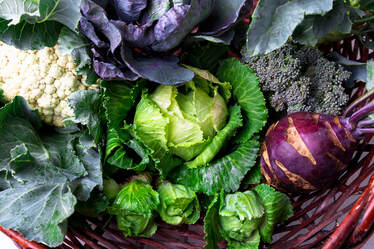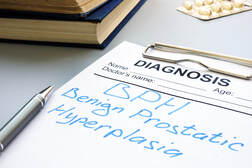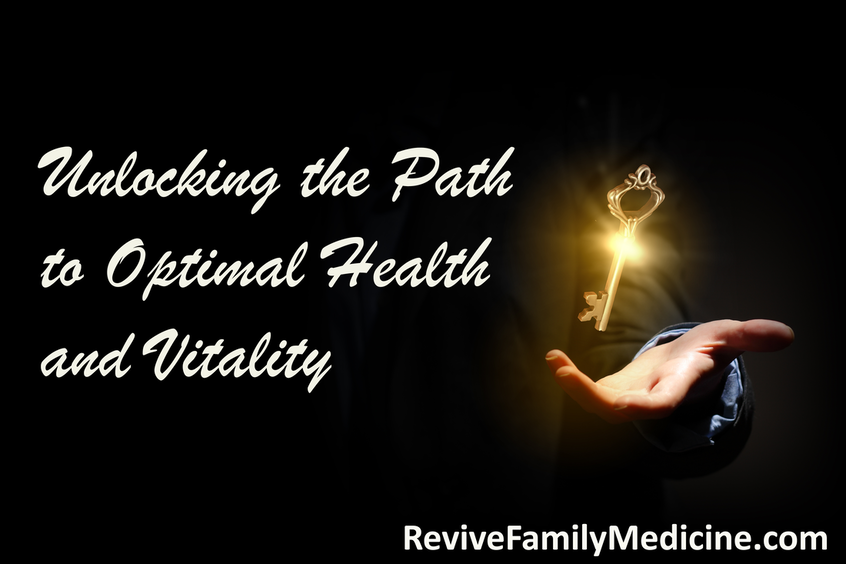|
If you are struggling with a chronic disease. Ask your doctor to help you in these areas.
Nutrition: every day, we have at least three opportunities to take in substances that will either hinder or help our healing. Physical Activity: 30 min. 5 days/week (150 min./wk.) of moderate intensity (can still talk but cannot sing) is critical for long-term health. Restorative Sleep: both quality and quantity are important. Stress Management: Chronic stress has a harmful effect on our immune system and our ability to shed excess weight. Nutrition, Physical Activity, and Restorative Sleep are key parts of stress management. Mindfulness is an excellent addition. Avoidance of Risky Substances: Tobacco, alcohol, toxic additives, etc... Social Connection: Healthy relationships at home and at work contribute or detract from our health and wellbeing. Also, a healthy sense of purpose and meaning in life provides a source of strength. Reach out to us Revive Family Medicine if you want to explore adding these pillars to your health care.
0 Comments
 Cruciferous vegetables are nature's little powerhouses. They packed with nutrients and health benefits. Here's a quick rundown of why you should load up your plate with these nutritional gems: 1. Cancer-Fighting Properties: These veggies contain compounds called glucosinolates, which have been shown to have anti-cancer properties. Research suggests that cruciferous vegetables may help reduce the risk of certain cancers. These include lung, prostate, breast, and colorectal cancer. [https://doi.org/10.1093/annonc/mdr604] 2. Heart Health: Regular consumption of cruciferous vegetables has been associated with a lower risk of heart disease. Their high fiber content helps to lower cholesterol levels. Other compounds support healthy blood pressure and inflammation levels. [PMID: 21593509] 3. Anti-Inflammatory Effects: Cruciferous vegetables are rich in antioxidants and anti-inflammatory compounds. These include flavonoids, glucosinolates, and sulforaphane. These compounds help combat inflammation and reduce the risk of chronic diseases. [https://doi.org/10.1016/j.jff.2011.08.004] 4. Digestive Health: The fiber content in cruciferous veggies supports a healthy digestive system by promoting regular bowel movements. These fibers feeding beneficial gut bacteria, aiding in digestion, and reducing the risk of digestive disorders. [PMID: 36615700] 5. Weight Management: Low in calories but high in fiber and nutrients. Cruciferous vegetables are an excellent choice for weight management. Their fiber content helps keep you full and satisfied, aiding in weight loss, maintenance, and addressing metabolic syndrome. [PMID: 32984393] 6. Rich in nutrients: Cruciferous veggies like broccoli, kale, cabbage, Brussels sprouts are loaded with essential vitamins and minerals like vitamin C, vitamin K, folate, and potassium. They're also an excellent source of fiber, which is crucial for digestive health. 7. "Detox" The sulforaphane in cruciferous vegetables aids in the livers' natural process of eliminating toxins from the body. No need to spend money on "detox" gimmicks. Eat your veggies. [PMID: 26167297] The list could go on and on. Unless your doctor tells you otherwise, pack in at least 1 or 2 servings of raw every day (and more cooked). Kale, broccoli, and broccoli sprouts are among the most powerful of these treasures. I have seen a rapid improvement in patients when adding cruciferous and other vegetables. An easy way to do this is in a delicious green smoothie! #revivefamilymedicine #nutrition #foodismedicine  This is for men and for the man in your life that you love:
If so, you are not alone. 50% of men by the age of 50 and 80% of men by the age of 80 experience symptoms of BPH—Benign Prosthetic Hyperplasia. The good news is, when you catch it early, it is almost always reversible without the use of prescription medications that can have unwanted side effects such as ED. Reach out to us at Revive Family Medicine and get started today on a plan to turn it around.  Are you struggling with an autoimmune disease? Have your past efforts fallen short on achieving a good resolution? Don't give up! Let's move forward together! Real science based solutions exist that go beyond simple medications. A combination of therapeutic nutrition (with food you can buy at a local store), sleep, stress reduction, exercise, and herbal medicine are only a few of the tools that can help. And yes, sometimes prescription medication. We are here to help! Finding solutions to the barriers that get in the way of the above is a lot of what we do at Revive Family Medicine. Reach out and schedule a free 30 minute discovery session to see how we can work together. #revivefamilymedicine #sle #hashimotos #gravesdisease #scleraderma #healthylife #herbalism #nutrition  In our fast-paced world, we often utter the words, "I don't have time." This sentiment is frequently associated with neglecting our health - whether it's skipping exercise, opting for fast food over a home-cooked meal, or succumbing to the endless scroll of social media. It's a reality many of us can relate to, myself included. However, it's vital to acknowledge that our health should be a priority. If we truly don't have time for healthy habits, perhaps it's time to reevaluate how we allocate our time. One of the major culprits of time consumption is the internet and social media. It's astonishing how much time we dedicate to scrolling, watching videos, and engaging with online content. What if we redirected even a fraction of that time towards something beneficial for our health? A few minutes of stretching, a quick set of exercises, or preparing a simple, nutritious meal can make a significant impact. These small actions may seem trivial, but they can pave the way to a healthier lifestyle. Let's challenge ourselves to stop making excuses and start taking practical steps towards a healthier life. It doesn't have to be a complete overhaul all at once. Rather, it's about making progress one step at a time, one meal at a time, and one day at a time. By prioritizing our health in small, manageable ways, we can gradually build a foundation for a healthier and more fulfilling life. Remember, every small effort counts, and you can make positive changes for your well-being. Schedule your free 30 minute Discovery Session with us today to see if there is some way we can help you on your health journey. When we think of food, we often consider its role in providing us with energy and essential nutrients. However, have you ever stopped to think about food as information? Beyond just sustaining our bodies, the food we consume actually communicates with our cells, triggering reactions and influencing our overall health. Proteins, carbohydrates, and fats are not only sources of energy but also convey important information to our bodies, impacting our DNA expression and cellular responses.
Every time we eat, we make choices that can either support or hinder our body's natural processes. The substances in our food can set off cascades of chemical reactions, stimulating our cells and influencing our DNA expression. This means that the information carried by the food we consume plays a crucial role in determining whether our bodies are stimulated towards health or hindered by harmful effects. Therefore, it's important to consider the information that our food is providing and the impact it has on our overall well-being. By recognizing the power of food as information, we can make informed choices that support our health and well-being. It's not always easy, but by understanding the role of food as an information source, we can work together to create an environment where healthier choices are more readily available to all of us. Let's be mindful of the information we're feeding our bodies and strive to make choices that promote a healthier and more vibrant life for ourselves and those around us.  In today's society, chronic diseases stemming from excessive calorie intake and depleted nutrition are rampant, plaguing not just our nation but the world at large. The alarming increase in conditions such as dementia, heart disease, cancers, and diabetes is a wake-up call to the dire need for change. It's clear that our current path is unsustainable, leading to a decline in health and well-being for many individuals. However, amidst this concerning trend, there is hope. By resetting our bodies' natural systems and aligning with a more balanced and wholesome lifestyle, we can unlock the potential for healing and thriving. Addressing the root causes of these chronic diseases presents an opportunity to tackle multiple health issues simultaneously. While it may not be a guarantee that every condition can be completely reversed, there is strong evidence suggesting that many of these diseases are largely avoidable and, to some extent, reversible. This offers a beacon of hope for individuals seeking to take control of their health and well-being. By making the conscious choice to prioritize a healthy lifestyle, we not only improve our own future but also contribute to a collective shift towards a healthier society. Choosing a path towards vitality over simply longevity is a powerful mindset shift. It emphasizes the importance of not just living longer, but living with energy, vigor, and overall well-being. By collectively embracing this journey and making the healthy choice the easy choice, we can pave the way for a sustainable and vibrant future. So, let's embark on this journey together, making today the starting point for a healthier and more vital tomorrow. Reach out today if you are ready to get started. We are here to help! #ReviveFamilyMedicine #Health #Vitality  The healing process often begins with sharing your story and having it heard with compassion and empathy. At Revive Family Medicine we start with listening to your story, your health journey, and what you want to accomplish. Bringing things into the light in a safe and caring environment can help start the healing process. You do not have to go your healing journey alone. We start by listening to you and your story. Reach out and let your journey toward renewed health and vitality start today. #revivefamilymedicine #healing #storytelling  Hi friends! Today, I want to share with you a little something I've learned about maintaining our health and vitality in the long run. It's not just about having strong willpower and making the right choices every single time. It's also about setting up our environment to make it easier for us to choose the healthy option. I mean, think about it - if there's a tub of ice cream and a bag of chips staring you in the face every time you open the cupboard, it's going to be tough to resist, right? I totally get it - we all have our weak moments, especially after a rough day or an awful night's sleep. Our willpower can only take us so far. Maybe it's time to make a few changes around the house. How about stocking up on some healthy, low-calorie snacks instead? Start with stocking up on some healthy, low-calorie snacks. Fruits and vegetables with a healthy dip such as hummus. Continue with removing the things that tempt you the most when you are the most vulnerable. It might take a little effort, especially if you live with others who have different preferences, but it's worth a shot. And hey, maybe you can even get your family or housemates on board with the idea! So, let's make it easier for ourselves. Let's create an environment that nudges us in the right direction, towards making healthier choices, without even having to think too hard about it. Because, in the end, it's not about making the unhealthy choice difficult - it's about making the easy choice the healthy choice. And trust me, that can make all the difference in the world.  In today’s fast-paced society, it often feels like an uphill battle to achieve victory in our quest for better health. The prevalence of chronic diseases, resulting from excessive calories, low nutrient, and often synthetic diet, is a growing concern. Do not lose hope. Amidst this disconcerting reality, there is good news to be embraced. By resetting our internal systems to their natural state, we can reclaim our innate ability to thrive. We are designed to heal. When we give our bodies the right stuff, it does a good job of taking care of most of the rest. It is high time we align ourselves with our bodies’ natural design, allowing them to heal and function optimally. Failure to do so will only lead to further deterioration in our health and an alarming rise in debilitating conditions like dementia, heart disease, cancer, and diabetes. One of the most promising aspects of addressing these diseases lies in understanding their root causes and implementing foundational solutions. While it would be overly optimistic to claim that every condition can be completely reversed, significant evidence suggests that they are often avoidable and, to some extent, even reversible. The keys to unlock this path are already yours. It starts with food that is rich in nutrients and lower in calories, movement, and restorative rest. Food: When we eat food that is loaded with micronutrients (vitamins, minerals, phytonutrient) and dilute in calories are bodies can repair and rebuild. Movement: They say, “sitting is the new smoking”. I am not sure if this is the case. However, our sedentary lifestyle is draining the life out of us. Restorative Rest: Sleep, both quality and quantity, are essential for our mind and body to repair. Each of these areas is important. The concepts are simple; but the implementation is complex. The path to a healthier future lies in our hands, individually and collectively. By making conscious choices that prioritize our well-being daily, we can pave the way for long-term success. It is essential to remember that the goal is not just longevity, but vitality–a life filled with energy, vigor, and overall well-being. Embarking on this journey towards better health requires a proactive mindset and a commitment to change. It starts with you! Make a choice today to regain your health. Your choice to change may be the catalyst your family and friends need to start their health journey. Even better, let’s do it together! Many studies show that getting healthy in a group leads to better outcomes. Let us embrace the hope that lies within us to alter our course and forge a healthier future. Today marks the beginning of a new chapter—a chapter where we prioritize our health, vitality, and overall well-being. Are you ready to embark on this transformative journey? The choice is yours. We are here to help. |
AuthorWrite something about yourself. No need to be fancy, just an overview. Archives
April 2024
Categories |

 RSS Feed
RSS Feed